Travel
Search
A CANYON IN THE
|
|
Harlan Hague
I'm sure I have not always been successful in avoiding a pained expression when I hear someone say, yes, he has been to Texas, but he sure doesn't like it because it is so flat and monotonous. I know the answer to my question, but I ask it anyway. "Where have you been in Texas?" The answer invariably confirms that the traveler has crossed the Texas panhandle between New Mexico and Oklahoma. He has seen Texas about as thoroughly as the visitor to Calais has seen France. Now I must add quickly that I do not agree with this unhappy traveler's judgment. I happen to like the Texas plains. There is a haunting beauty about them that is best appreciated on the outside of your car and away from the highway, especially when there is a scattered herd of grazing whiteface Herefords in the distance and a hawk high in the sky riding a gentle breeze and a quiet that almost hurts your ears.Nevertheless, if you need something dramatic to break the "monotony" of the prairie, you can find it right in the middle of the panhandle. Just twenty-three miles southeast of Amarillo, Palo Duro Canyon surprises even those who know what to expect. There is no hint of its existence on the flat plain until you are almost upon it. Unlike the Grand Canyon, which was carved by a large river as the land uplifted, the
Palo Duro Canyon was sculpted by wind and the action of a The eroded walls of the canyon reveal geological change over millions of years. The sedimentary rocks deposited in layers during the four geological periods represented are a melange of subdued color, from the deep red shales and white gypsum at the canyon floor, passing up the walls through the red, lavender, yellow and gray layers of sandstone and shale to the pinks and tans of the rimrock. The best times to see the canyon are at the beginning and end of day when the slanting rays of the sun play on the multi-colored walls. Each degree of the sun's movement reveals a new picture of light, shadow and hue. The canyon is rich in wildlife and vegetation. Perennial springs and the stream that
meanders through the valley make this an attractive oasis in a land that is often parched
in summer. Stone age man
Palo Duro Canyon is now a state park. Visit the interpretive center near the park entrance, and stop at the nearby observation point for the best view of the canyon from the rim. Then drive the road that drops rather sharply down to the valley floor. The road winds for eight miles through the valley, crossing the Prairie Dog Fork six times. The stream is shallow and easily crossed. On one summer visit, at three fords I saw children in shorts and sundresses sitting in the water and splashing happily. I was tempted to join them.
The park has a unique attraction that is as famous locally as the canyon itself. During
the summer months, "Texas," a muscial production, is staged each evening except
Wednesday in the amphitheater on the canyon floor. Advance reservations are strongly
advised. As you drive from the canyon floor up to the rim, keep a sharp eye out, and you may see some of the longhorns that graze in the park. I saw four sleek animals who walked slowly, cropping the sparse grass, until they were almost next to the fence where I stood. One posed very nicely for me, his head up and his huge, symmetrical horns outlined against the evening sky. Then he dropped his head and wandered off. Nothing like his ancestors who had a reputation for being lean, mean and wild. Now that you have had an exposure to the land and history of the region, finish off with a visit to the Panhandle-Plains Historical Museum at the town of Canyon, twelve miles due west of the park. The museum includes exhibits of the archaeology, ecology, natural history and geology of the panhandle. Historical displays at the museum include a hall of Texas history and special exhibits on the southern Plains Indians and ranching. There are galleries of western art and fashion and an indoor pioneer village made of authentic structures that have been brought here from throughout the region. The adjacent museum annex houses a rather exceptional collection of antique wagons, buggies, cars and sleighs. Just north of the annex is the T-Anchor Ranch Headquarters, the oldest known panhandle building. The log structure, built in 1877, and outbuildings were moved here from their original West Texas location.
Photos courtesy Palo Duro Canyon State Park. |
|
Caveat and disclaimer: This is a freelance travel article that I published some time ago. Some data, especially prices, links and contact information, may not be current. |
|
|
|
|
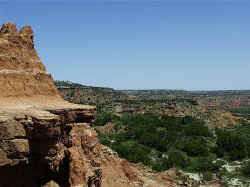 small stream, the Prairie Dog Town Fork of the Red
River, from the geologically stable plain. The canyon is impressive, 800 feet deep and 120
miles long.
small stream, the Prairie Dog Town Fork of the Red
River, from the geologically stable plain. The canyon is impressive, 800 feet deep and 120
miles long. 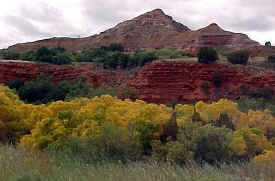 hunted here 12,000 years
ago. A number of plains Indian tribes subsequently occupied the canyon. It was the
fortress from which Comanches in the nineteenth century sallied out to attack the
Americans who had invaded their land. Coronado was likely the first European to see the
canyon. He had led a sizable expedition north from Mexico into present-day New Mexico
looking for the rumored Seven Cities of Cibola. Finding only poor pueblos there, he
decided that the rich cities must be elsewhere. Following another rumor-monger, he passed
through the Texas panhandle in 1541 searching for the fabled Quivira.
hunted here 12,000 years
ago. A number of plains Indian tribes subsequently occupied the canyon. It was the
fortress from which Comanches in the nineteenth century sallied out to attack the
Americans who had invaded their land. Coronado was likely the first European to see the
canyon. He had led a sizable expedition north from Mexico into present-day New Mexico
looking for the rumored Seven Cities of Cibola. Finding only poor pueblos there, he
decided that the rich cities must be elsewhere. Following another rumor-monger, he passed
through the Texas panhandle in 1541 searching for the fabled Quivira. 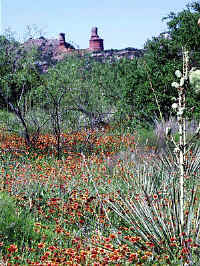 The canyon country was
explored in l852 by a United States army expedition under Captain R. B. Marcy. Charles
Goodnight in 1876 drove from the canyon the buffalo that had been missed by the voracious
hide hunters and brought in 1,600 cattle. Goodnight's was the first ranch in the
panhandle, and others followed quickly.
The canyon country was
explored in l852 by a United States army expedition under Captain R. B. Marcy. Charles
Goodnight in 1876 drove from the canyon the buffalo that had been missed by the voracious
hide hunters and brought in 1,600 cattle. Goodnight's was the first ranch in the
panhandle, and others followed quickly.  Don't be deceived by the pleasant, languid little
stream. In wet weather, stay away from the fords. Flash floods are not uncommon during
heavy rains.
Don't be deceived by the pleasant, languid little
stream. In wet weather, stay away from the fords. Flash floods are not uncommon during
heavy rains. 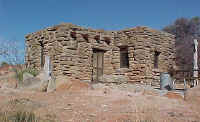 There are picnic sites in the canyon, hiking trails
and horses for rent. Campgrounds, some with electrical hook-ups, are scattered throughout
the valley. The Palo Duro Trading Post stocks camping supplies and souvenirs. For views
that canot be seen from the road, book a place in a guided horseback tour at the Old West
Stables.
There are picnic sites in the canyon, hiking trails
and horses for rent. Campgrounds, some with electrical hook-ups, are scattered throughout
the valley. The Palo Duro Trading Post stocks camping supplies and souvenirs. For views
that canot be seen from the road, book a place in a guided horseback tour at the Old West
Stables. 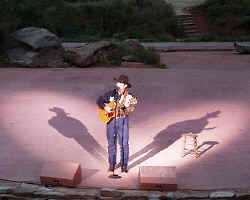 The setting is dramatic, and the music is stirring.
Before the evening is over, you will be a Texan in spirit if not in fact.
The setting is dramatic, and the music is stirring.
Before the evening is over, you will be a Texan in spirit if not in fact. 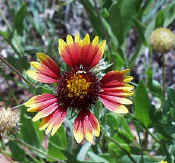 For a park brochure, write to Park Superintendent,
Palo Duro Canyon State Park, 11450 Park Road 5, Canyon, Texas 79015. Get descriptive
materials on the museum from Panhandle-Plains Historical Museum, WTAMU Box 967, Canyon,
Texas 79016, telephone (806) 656-2244. If you plan a visit during the summer months, send
for the brochure that describes the musical and the schedule of performances. The address
is:
For a park brochure, write to Park Superintendent,
Palo Duro Canyon State Park, 11450 Park Road 5, Canyon, Texas 79015. Get descriptive
materials on the museum from Panhandle-Plains Historical Museum, WTAMU Box 967, Canyon,
Texas 79016, telephone (806) 656-2244. If you plan a visit during the summer months, send
for the brochure that describes the musical and the schedule of performances. The address
is: